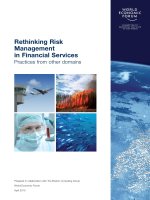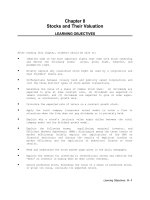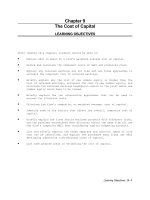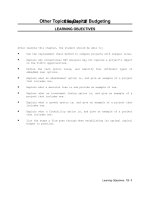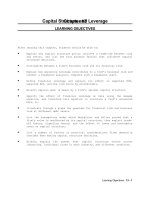Financial managment Solution Manual: Other Topics in Capital Budgeting
Bạn đang xem bản rút gọn của tài liệu. Xem và tải ngay bản đầy đủ của tài liệu tại đây (144.37 KB, 16 trang )
After reading this chapter, the student should be able to:
• Use the replacement chain method to compare projects with unequal lives.
• Explain why conventional NPV analysis may not capture a project’s impact
on the firm’s opportunities.
• Define the term option value, and identify four different types of
embedded real options.
• Explain what an abandonment option is, and give an example of a project
that includes one.
• Explain what a decision tree is and provide an example of one.
• Explain what an investment timing option is, and give an example of a
project that includes one.
• Explain what a growth option is, and give an example of a project that
includes one.
• Explain what a flexibility option is, and give an example of a project
that includes one.
• List the steps a firm goes through when establishing its optimal capital
budget in practice.
Learning Objectives: 12 - 1
Chapter 12
Other Topics in Capital Budgeting
LEARNING OBJECTIVES
This chapter covers some important but relatively technical topics. Note too
that this chapter is more modular than most, i.e., the major sections are
discrete, hence they can be omitted without loss of continuity. Therefore, if
you are experiencing a time crunch, you could skip sections or even the entire
chapter.
Assuming you are going to cover the entire chapter, the details of what
we cover, and the way we cover it, can be seen by scanning Blueprints, Chapter
12. For other suggestions about the lecture, please see the “Lecture
Suggestions” in Chapter 2, where we describe how we conduct our classes.
DAYS ON CHAPTER: 2 OF 58 DAYS (50-MINUTE PERIODS)
Lecture Suggestions: 12 - 2
LECTURE SUGGESTIONS
12-1 Generally, the failure to employ common life analysis or the equivalent
annual annuity approach in such situations will bias the NPV against the
shorter project because it “gets no credit” for profits beyond its
initial life, even though it could possibly be “renewed” and thus
provide additional NPV.
12-2 Postponing the project means that cash flows come later rather than
sooner; however, waiting may allow you to take advantage of changing
conditions. It might make sense, however, to proceed today if there are
important advantages to being the first competitor to enter a market.
12-3 Timing options make it less likely that a project will be accepted
today. Often, if a firm can delay a decision, it can increase the
expected NPV of a project.
12-4 Having the option to abandon a project makes it more likely that the
project will be accepted today.
Answers and Solutions: 12 - 3
ANSWERS TO END-OF-CHAPTER QUESTIONS
12-1 a. Project A: 0 1 2
| | |
-10,000 6,000 8,000
Using a financial calculator, input the following data: CF
0
= -10000,
CF
1
= 6000, CF
2
= 8000, I = 10, and then solve for NPV
A
= $2,066.12.
Project B: 0 1 2 3 4
| | | | |
-10,000 4,000 4,000 4,000 4,000
Using a financial calculator, input the following data: CF
0
= -10000,
CF
1-4
= 4000, I = 10, and then solve for NPV
B
= $2,679.46.
Since neither project can be repeated, Project B should be selected
because it has a higher NPV than Project A.
b. To determine the answer to part b, we must use the replacement chain
(common life) approach to calculate the extended NPV for Project A.
Project B already extends out to 4 years, so its NPV is $2,679.46.
Project A: 0 1 2 3 4
| | | | |
-10,000 6,000 8,000 6,000 8,000
-10,000
-2,000
Using a financial calculator, input the following data: CF
0
= -10000,
CF
1
= 6000, CF
2
= -2000, CF
3
= 6000, CF
4
= 8000, I = 10, and then solve
for NPV
A
= $3,773.65.
Since Project A’s extended NPV = $3,773.65, it should be selected over
Project B with an NPV = $2,679.46.
12-2 WACC
1
= 12%; WACC
2
= 12.5%.
Since each project is independent and of average risk, all projects whose
IRR > WACC will be accepted. Consequently, Projects A, B, C, D, and E
will be accepted and the optimal capital budget is $5,250,000.
12-3 Since Projects C and D are now mutually exclusive only one of them can be
accepted. The project with the higher NPV should now be chosen.
Therefore, Project D should be selected over Project C. The projects now
selected are A, B, D, and E with an optimal capital budget of $4 million.
Answers and Solutions: 12 - 4
SOLUTIONS TO END-OF-CHAPTER PROBLEMS
10%
10%
k = 10%
12-4 Risk-adjusted
Projects Risk WACC IRR Decision
A High 14.5% 14.0% Reject
B Average 12.5 13.5 Accept
C Average 12.5 13.2 Accept
D Average 12.5 13.0 Accept
E Average 12.5 12.7 Accept
F Low 10.5 12.3 Accept
G Low 10.5 12.2 Accept
On the basis of a risk-adjusted WACC, Projects B, C, D, E, F, and G will
be accepted and only Project A will be rejected. The firm’s optimal
capital budget is $6 million.
12-5 NPV
190-3
= $11,982 (for 3 years).
Extended NPV
190-3
= $11,982 + $11,982/(1.14)
3
= $20,070.
NPV
360-6
= $22,256 (for 6 years).
Both new machines have positive NPVs; hence the old machine should be
replaced. Further, since its NPV is greater, choose Model 360-6.
12-6 Plane A: Expected life = 5 years; Cost = $100 million; NCF = $30 million;
COC = 12%.
Plane B: Expected life = 10 years; Cost = $132 million; NCF = $25
million; COC = 12%.
A: 0 1 2 3 4 5 6 7 8 9 10
|
| | | | | | | | | |
-100 30 30 30 30 30 30 30 30 30 30
-100
-70
Enter these values into the cash flow register: CF
0
= -100; CF
1-4
= 30;
CF
5
= -70; CF
6-10
= 30. Then enter I = 12, and press the NPV key to get
NPV
A
= $12.764 ≈ $12.76 million.
B: 0 1 2 3 4 5 6 7 8 9 10
|
| | | | | | | | | |
-132 25 25 25 25 25 25 25 25 25 25
Enter these cash flows into the cash flow register, along with the
interest rate, and press the NPV key to get NPV
B
= $9.256 ≈ $9.26 million.
Project A is the better project and will increase the company's value
by $12.76 million.
12-7 A: 0 1 2 3 4 5 6 7 8
| | | | | | | | |
-10 4 4 4 4 4 4 4 4
Answers and Solutions: 12 - 5
12%
12%
10%
-10
-6
Machine A’s simple NPV is calculated as follows: Enter CF
0
= -10 and
CF
1-4
= 4. Then enter I = 10, and press the NPV key to get NPV
A
= $2.679
million. However, this does not consider the fact that the project can
be repeated again. Enter these values into the cash flow register: CF
0
= -10; CF
1-3
= 4; CF
4
= -6; CF
5-8
= 4. Then enter I = 10, and press the NPV
key to get Extended NPV
A
= $4.5096 ≈ $4.51 million.
B: 0 1 2 3 4 5 6 7 8
| | |
| | | | | |
-15 3.5 3.5 3.5 3.5 3.5 3.5 3.5 3.5
Enter these cash flows into the cash flow register, along with the
interest rate, and press the NPV key to get NPV
B
= $3.672 ≈ $3.67
million.
Machine A is the better project and will increase the company's value
by $4.51 million.
12-8 a. 0 1 2 20
| | | • • • |
-20 3 3 3
NPV = $2.4083 million.
b. Wait 1 year:
NPV @
0 1 2 3 21 Yr. 0
Tax imposed | | | | • • • |
25% Prob. 0 -20 2.4 2.4 2.4 -$1.8512
Tax not imposed | | | | • • • |
75% Prob. 0 -20 3.2 3.2 3.2 3.2 3.4841
Note though, that if the tax is imposed, the NPV of the project is
negative and therefore would not be undertaken. The value of this
option of waiting one year is evaluated as 0.25($0) + (0.75)($3.4841)
= $2.6131 million.
Since the NPV of waiting one year is greater than going ahead and
proceeding with the project today, it makes sense to wait.
12-9 a. NPV of abandonment after Year t:
Using a financial calculator, input the following: CF
0
= -22500,
CF
1
= 23750, and I = 10 to solve for NPV
1
= -$909.09 ≈ -$909.
Using a financial calculator, input the following: CF
0
= -22500,
CF
1
= 6250, CF
2
= 20250, and I = 10 to solve for NPV
2
= -$82.64 ≈ -$83.
Answers and Solutions: 12 - 6
10%
12%
k = 12%
Using a financial calculator, input the following: CF
0
= -22500,
CF
1
= 6250, N
j
= 2, CF
3
= 17250, and I = 10 to solve for NPV
3
=
$1,307.29 ≈ $1,307.
Using a financial calculator, input the following: CF
0
= -22500,
CF
1
= 6250, N
j
= 3, CF
4
= 11250, and I = 10 to solve for NPV
4
=
$726.73 ≈ $727.
Using a financial calculator, input the following: CF
0
= -22500,
CF
1
= 6250, N
j
= 5, and I = 10 to solve for NPV
5
= $1,192.42 ≈ $1,192.
The firm should operate the truck for 3 years, NPV
3
= $1,307.
b. No. Abandonment possibilities could only raise NPV and IRR. The
value of the firm is maximized by abandoning the project after Year 3.
12-10 a. 0 1 2 3 4
| | | | |
-8 4 4 4 4
NPV = $4.6795 million.
b. Wait 2 years:
NPV @
0 1 2 3 4 5 6 Yr. 0
| | | | | | |
10% Prob. 0 0 -9 2.2 2.2 2.2 2.2 -$1.6746
| | | | | | |
90% Prob. 0 0 -9 4.2 4.2 4.2 4.2 3.5648
If the cash flows are only $2.2 million, the NPV of the project is
negative and, thus, would not be undertaken. The value of the option
of waiting two years is evaluated as 0.10($0) + 0.90($3.5648) =
$3.2083 million.
Since the NPV of waiting two years is less than going ahead and
proceeding with the project today, it makes sense to drill today.
12-11 a. 0 1 14 15
| | • • • | |
-6,200,000 600,000
600,000 600,000
Using a financial calculator, input the following data: CF
0
= -6200000;
CF
1-15
= 600000; I = 12; and then solve for NPV = -$2,113,481.31.
Answers and Solutions: 12 - 7
10%
12%
k = 10%
b. 0 1 14 15
| | • • • | |
-6,200,000 1,200,000
1,200,000 1,200,000
Using a financial calculator, input the following data: CF
0
=
-6200000; CF
1-15
= 1200000; I = 12; and then solve for NPV =
$1,973,037.39.
c. If they proceed with the project today, the project’s expected NPV =
(0.5 × -$2,113,481.31) + (0.5 × $1,973,037.39) = -$70,221.96. So,
Nevada Enterprises would not do it.
d. Since the project’s NPV with the tax is negative, if the tax were
imposed the firm would abandon the project. Thus, the decision tree
looks like this:
NPV @
0 1 2 15 Yr. 0
50% Prob. | | | • • • |
Taxes -6,200,000 6,000,000 0 0 -$ 842,857.14
No Taxes | | | • • • |
50% Prob. -6,200,000 1,200,000 1,200,000 1,200,000 1,973,037.39
Expected NPV $ 565,090.13
Yes, the existence of the abandonment option changes the expected NPV
of the project from negative to positive. Given this option the firm
would take on the project because its expected NPV is $565,090.13.
e. NPV @
0 1 Yr. 0
50% Prob. | |
Taxes NPV = ? -1,500,000 $ 0.00
+300,000 = NPV @ t = 1
No Taxes | |
50% Prob. NPV = ? -1,500,000 2,232,142.86
+4,000,000 = NPV @ t = 1 Expected NPV $1,116,071.43
If the firm pays $1,116,071.43 for the option to purchase the land,
then the NPV of the project is exactly equal to zero. So the firm
would not pay any more than this for the option.
Answers and Solutions: 12 - 8
12%
k = 12%
k = 12%
}
wouldn’t do
12-12 The detailed solution for the spreadsheet problem is available both on
the instructor’s resource CD-ROM and on the instructor’s side of South-
Western’s web site, .
Spreadsheet Problem: 12 - 9
SPREADSHEET PROBLEM
21st Century Educational Products
Other Topics in Capital Budgeting
12-13 21ST CENTURY EDUCATIONAL PRODUCTS (21ST CENTURY) IS A RAPIDLY GROWING
SOFTWARE COMPANY, AND CONSISTENT WITH ITS GROWTH, IT HAS A RELATIVELY
LARGE CAPITAL BUDGET. WHILE MOST OF THE COMPANY’S PROJECTS ARE
FAIRLY EASY TO EVALUATE, A HANDFUL OF PROJECTS INVOLVE MORE COMPLEX
EVALUATIONS.
JOHN KELLER, A SENIOR MEMBER OF THE COMPANY’S FINANCE STAFF,
COORDINATES THE EVALUATION OF THESE MORE COMPLEX PROJECTS. HIS GROUP
BRINGS THEIR RECOMMENDATIONS DIRECTLY TO THE COMPANY’S CFO AND CEO,
KRISTIN RILEY AND BOB STEVENS, RESPECTIVELY.
A. RIGHT NOW, KELLER’S GROUP IS LOOKING AT A VARIETY OF INTERESTING
PROJECTS. FOR EXAMPLE, THE GROUP HAS BEEN ASKED TO CHOOSE BETWEEN
THE FOLLOWING TWO MUTUALLY EXCLUSIVE PROJECTS:
EXPECTED NET CASH FLOWS
YEAR PROJECT S PROJECT L
0 ($100,000) ($100,000)
1 59,000 33,500
2 59,000 33,500
3 33,500
4 33,500
BOTH PROJECTS MAY BE REPEATED AND BOTH ARE OF AVERAGE RISK, SO THEY
SHOULD BE EVALUATED AT THE FIRM'S COST OF CAPITAL, 10 PERCENT.
WHICH ONE SHOULD BE CHOSEN?
ANSWER: [SHOW S12-1 THROUGH S12-4 HERE.]
PROJECT S: 0 1 2 3 4
| | | | |
-100,000 59,000 59,000 59,000 59,000
-100,000
-41,000
Integrated Case: 12 - 10
INTEGRATED CASE
10%
USING A FINANCIAL CALCULATOR, INPUT THE FOLLOWING DATA: CF
0
=
-100000; CF
1
= 59000; CF
2
= -41000; CF
3-4
= 59000; I = 10; AND THEN
SOLVE FOR NPV = $4,377.43.
PROJECT L: 0 1 2 3 4
| | | | |
-100,000 33,500 33,500 33,500 33,500
USING A FINANCIAL CALCULATOR, INPUT THE FOLLOWING DATA: CF
0
=
-100000; CF
1-4
= 33500; I = 10; AND THEN SOLVE FOR NPV = $6,190.49.
PROJECT L SHOULD BE CHOSEN SINCE IT HAS A HIGHER NPV THAN PROJECT S.
B. IN RECENT MONTHS, KELLER’S GROUP HAS BEGUN TO FOCUS ON REAL OPTION
ANALYSIS.
1. WHAT IS REAL OPTION ANALYSIS?
ANSWER: [SHOW S12-5 HERE.] REAL OPTIONS EXIST WHEN MANAGERS CAN INFLUENCE
THE SIZE AND RISKINESS OF A PROJECT’S CASH FLOWS BY TAKING DIFFERENT
ACTIONS DURING OR AT THE END OF A PROJECT’S LIFE.
REAL OPTION ANALYSIS INCLUDES IN THE TYPICAL NPV CAPITAL BUDGETING
ANALYSIS AN ANALYSIS FOR OPPORTUNITIES FOR MANAGERS TO RESPOND TO
CHANGING CIRCUMSTANCES BECAUSE MANAGEMENT’S ACTIONS CAN INFLUENCE A
PROJECT’S OUTCOME.
B. 2. WHAT ARE SOME EXAMPLES OF PROJECTS WITH EMBEDDED REAL OPTIONS?
ANSWER: [SHOW S12-6 HERE.] A PROJECT MAY CONTAIN ONE OR MORE DIFFERENT TYPES
OF EMBEDDED REAL OPTIONS. EXAMPLES INCLUDE ABANDON-MENT/SHUTDOWN
OPTIONS, INVESTMENT TIMING OPTIONS, GROWTH/EXPANSION OPTIONS, AND
FLEXIBILITY OPTIONS.
C. TAKING REAL OPTIONS INTO ACCOUNT, ONE OF KELLER’S COLLEAGUES, BARBARA
HUDSON, HAS SUGGESTED THAT INSTEAD OF INVESTING IN PROJECT L TODAY,
IT MIGHT MAKE SENSE TO WAIT A YEAR BECAUSE 21ST CENTURY WOULD LEARN A
LOT MORE ABOUT MARKET CONDITIONS AND WOULD BE BETTER ABLE TO FORECAST
THE PROJECT'S CASH FLOWS. RIGHT NOW, 21ST CENTURY FORECASTS THAT
Integrated Case: 12 - 11
10%
PROJECT L WILL GENERATE EXPECTED YEARLY NET CASH FLOWS OF $33,500.
HOWEVER, IF THE COMPANY WAITS A YEAR, IT WILL LEARN MORE ABOUT MARKET
CONDITIONS. THERE IS A 50 PERCENT CHANCE THAT THE MARKET WILL BE
STRONG AND A 50 PERCENT CHANCE IT WILL BE WEAK. IF THE MARKET IS
STRONG, THE YEARLY CASH FLOWS WILL BE $43,500. IF THE MARKET IS
WEAK, THE YEARLY CASH FLOWS WILL BE ONLY $23,500. IF 21ST CENTURY
CHOOSES TO WAIT A YEAR, THE INITIAL INVESTMENT WILL REMAIN $100,000.
ASSUME THAT ALL CASH FLOWS ARE DISCOUNTED AT 10 PERCENT. SHOULD 21ST
CENTURY INVEST IN PROJECT L TODAY, OR SHOULD IT WAIT A YEAR BEFORE
DECIDING WHETHER TO INVEST IN THE PROJECT?
ANSWER: [SHOW S12-7 THROUGH S12-9 HERE.]
50% PROB. 0 1 2 3 4 5 NPV
STRONG MKT. | | | | | | @ t = 1
0 -100,000 43,500 43,500 43,500 43,500 $37,889.15
WEAK MKT. | | | | | |
50% PROB. 0 -100,000 23,500 23,500 23,500 23,500 -25,508.16
HOWEVER, IN A WEAK MARKET THE FIRM WILL NOT UNDERTAKE PROJECT L SINCE
ITS NPV < 0. CONSEQUENTLY, THE EXPECTED NPV OF WAITING ONE YEAR IS
(0.5)$0 + (0.5)($37,889.15) = $18,944.58. HOWEVER, THIS IS THE
PRESENT VALUE AT YEAR 1, SO MUST DISCOUNT IT BACK ONE YEAR TO FIND
THE VALUE TODAY OF WAITING TO DO PROJECT L. SO, THE VALUE TODAY OF
WAITING IS CALCULATED AS $18,944.58/1.10 = $17,222.34. THEREFORE, THE
FIRM SHOULD WAIT TO GET MORE INFORMATION ABOUT THE MARKET RATHER THAN
UNDERTAKING PROJECT L TODAY BECAUSE THE NPV IS $17,222.34 COMPARED TO
$6,190.49, THE NPV OF DOING IT TODAY.
D. NOW LET’S ASSUME THAT THERE IS MORE UNCERTAINTY ABOUT THE FUTURE CASH
FLOWS. MORE SPECIFICALLY, ASSUME THAT THE YEARLY CASH FLOWS ARE NOW
$53,500 IF THE MARKET IS STRONG AND $13,500 IF THE MARKET IS WEAK.
ASSUME THAT THE UP-FRONT COST IS STILL $100,000 AND THAT THE COST OF
CAPITAL IS STILL 10 PERCENT. WILL THIS INCREASED UNCERTAINTY MAKE
THE FIRM MORE OR LESS WILLING TO INVEST IN THE PROJECT TODAY?
Integrated Case: 12 - 12
k = 10%
ANSWER: [SHOW S12-10 AND S12-11 HERE.]
50% PROB. 0 1 2 3 4 5 NPV
STRONG MKT. | | | | | | @ t = 1
0 -100,000 53,500 53,500 53,500 53,500 $69,587.80
WEAK MKT. | | | | | |
50% PROB. 0 -100,000 13,500 13,500 13,500 13,500 -57,206.82
IN A WEAK MARKET THE FIRM WILL NOT UNDERTAKE PROJECT L SINCE ITS NPV
< 0. CONSEQUENTLY, THE EXPECTED NPV OF WAITING ONE YEAR IS (0.5)$0 +
(0.5)($69,587.80) = $34,793.90. HOWEVER, THIS IS THE PRESENT VALUE
AT YEAR 1, SO WE MUST DISCOUNT IT BACK ONE YEAR TO FIND THE VALUE
TODAY OF WAITING TO DO PROJECT L. SO, THE VALUE TODAY OF WAITING IS
CALCULATED AS $34,793.90/1.10 = $31,630.82. THEREFORE, THE FIRM
SHOULD WAIT TO GET MORE INFORMATION ABOUT THE MARKET RATHER THAN
UNDERTAKING PROJECT L TODAY BECAUSE THE NPV IS $31,630.82 COMPARED TO
$6,190.49, THE NPV OF DOING IT TODAY.
THE MORE VARIABLE THE CASH FLOWS (THE MORE UNCERTAINTY) THE LESS
WILLING THE FIRM WILL BE TO INVEST IN THE PROJECT TODAY.
FACTORS THE FIRM SHOULD CONSIDER WHEN DECIDING WHEN TO INVEST:
1. DELAYING THE PROJECT MEANS THAT CASH FLOWS COME LATER RATHER THAN
SOONER.
2. IT MIGHT MAKE SENSE TO PROCEED TODAY IF THERE ARE IMPORTANT
ADVANTAGES TO BEING THE FIRST COMPETITOR TO ENTER A MARKET.
3. WAITING MAY ALLOW YOU TO TAKE ADVANTAGE OF CHANGING CONDITIONS.
E. 21ST CENTURY IS CONSIDERING ANOTHER PROJECT, PROJECT Y. PROJECT Y HAS
AN UP-FRONT COST OF $200,000 AND AN ECONOMIC LIFE OF THREE YEARS. IF
THE COMPANY DEVELOPS THE PROJECT, ITS AFTER-TAX OPERATING COSTS WILL BE
$100,000 A YEAR; HOWEVER, THE PROJECT IS EXPECTED TO PRODUCE AFTER-TAX
CASH INFLOWS OF $180,000 A YEAR. THUS, THE PROJECT’S ESTIMATED CASH
FLOWS ARE AS FOLLOWS:
YEAR CASH OUTFLOWS CASH INFLOWS NET CASH FLOWS
0 -$200,000 $ 0 -$200,000
1 -100,000 180,000 80,000
2 -100,000 180,000 80,000
3 -100,000 180,000 80,000
Integrated Case: 12 - 13
k = 10%
1. THE PROJECT HAS AN ESTIMATED COST OF CAPITAL OF 10 PERCENT. WHAT IS
THE PROJECT’S NPV?
ANSWER: [SHOW S12-12 HERE.]
0 1 2 3
| | | |
-200,000 80,000 80,000 80,000
USING A FINANCIAL CALCULATOR, INPUT THE FOLLOWING DATA: CF
0
=
-200000; CF
1-3
= 80000; I = 10; AND THEN SOLVE FOR NPV = -$1,051.84.
E. 2. WHILE THE PROJECT’S OPERATING COSTS ARE FAIRLY CERTAIN AT $100,000
PER YEAR, THE ESTIMATED CASH INFLOWS DEPEND CRITICALLY ON WHETHER
21ST CENTURY'S LARGEST CUSTOMER USES THE PRODUCT. KELLER ESTIMATES
THAT THERE IS A 60 PERCENT CHANCE THE CUSTOMER WILL USE THE PRODUCT,
IN WHICH CASE THE PROJECT WILL PRODUCE AFTER-TAX CASH INFLOWS OF
$250,000. THUS, ITS NET CASH FLOWS WOULD BE $150,000 PER YEAR.
HOWEVER, THERE IS A 40 PERCENT CHANCE THE CUSTOMER WILL NOT USE THE
PRODUCT, IN WHICH CASE THE PROJECT WILL PRODUCE AFTER-TAX CASH
INFLOWS OF ONLY $75,000. THUS, ITS NET CASH FLOWS WOULD BE
-$25,000. WRITE OUT THE ESTIMATED CASH FLOWS, AND CALCULATE THE
PROJECT’S NPV UNDER EACH OF THE TWO SCENARIOS.
ANSWER: [SHOW S12-13 AND S12-14 HERE.]
CUSTOMER USES PRODUCT (60% PROBABILITY)
0 1 2 3
| | | |
-200,000 150,000 150,000 150,000
USING A FINANCIAL CALCULATOR, INPUT THE FOLLOWING DATA: CF
0
=
-200000; CF
1-3
= 150000; I = 10; AND THEN SOLVE FOR NPV = $173,027.80.
CUSTOMER DOESN’T USE PRODUCT (40% PROBABILITY)
0 1 2 3
| | | |
-200,000 -25,000 -25,000 -25,000
Integrated Case: 12 - 14
10%
10%
10%
USING A FINANCIAL CALCULATOR, INPUT THE FOLLOWING DATA: CF
0
=
-200000; CF
1-3
= -25000; I = 10; AND THEN SOLVE FOR NPV =
-$262,171.30.
E. 3. WHILE 21ST CENTURY DOES NOT HAVE THE OPTION TO DELAY THE PROJECT, IT
WILL KNOW ONE YEAR FROM NOW IF THE KEY CUSTOMER HAS SELECTED THE
PRODUCT. IF THE CUSTOMER CHOOSES NOT TO ADOPT THE PRODUCT, 21ST
CENTURY HAS THE OPTION TO ABANDON THE PROJECT. IF IT ABANDONS THE
PROJECT, IT WILL NOT RECEIVE ANY CASH FLOWS AFTER YEAR 1, AND IT WILL
NOT INCUR ANY OPERATING COSTS AFTER YEAR 1. THUS, IF THE COMPANY
CHOOSES TO ABANDON THE PROJECT, ITS ESTIMATED CASH FLOWS ARE AS
FOLLOWS:
0 1 2 3
| | | |
60% PROB. -200,000 150,000 150,000 150,000
| |
40% PROB. -200,000 -25,000
AGAIN, ASSUMING A COST OF CAPITAL OF 10 PERCENT, WHAT IS THE
PROJECT’S EXPECTED NPV IF IT ABANDONS THE PROJECT? SHOULD 21ST
CENTURY INVEST IN PROJECT Y TODAY, REALIZING IT HAS THE OPTION TO
ABANDON THE PROJECT AT t = 1?
ANSWER: [SHOW S12-15 AND S12-16 HERE.]
0 1 2 3 NPV @ t = 0
| | | |
60% PROB. -200,000 150,000 150,000 150,000 $173,027.80
| | -222,727.27
40% PROB. -200,000 -25,000
E(NPV) = 0.6($173,027.80) + 0.4(-$222,727.27)
= $14,725.77.
E. 4. UP UNTIL NOW WE HAVE ASSUMED THAT THE ABANDONMENT OPTION HAS NOT
AFFECTED THE PROJECT’S COST OF CAPITAL. IS THIS ASSUMPTION REASONABLE?
HOW MIGHT THE ABANDONMENT OPTION AFFECT THE COST OF CAPITAL?
Integrated Case: 12 - 15
k = 10%
ANSWER: [SHOW S12-17 HERE.] IT IS NOT REASONABLE TO ASSUME THAT THE
ABANDONMENT OPTION HAS NO EFFECT ON THE COST OF CAPITAL. HAVING THE
ABILITY TO ABANDON A PROJECT REDUCES RISK; THEREFORE, REDUCING ITS
COST OF CAPITAL.
F. FINALLY, 21ST CENTURY IS ALSO CONSIDERING PROJECT Z. PROJECT Z HAS
AN UP-FRONT COST OF $500,000, AND IT IS EXPECTED TO PRODUCE AFTER-TAX
CASH INFLOWS OF $100,000 AT THE END OF EACH OF THE NEXT FIVE YEARS (t
= 1, 2, 3, 4, AND 5). BECAUSE PROJECT Z HAS A COST OF CAPITAL OF 12
PERCENT, IT CLEARLY HAS A NEGATIVE NPV. HOWEVER, KELLER AND HIS
GROUP RECOGNIZE THAT IF 21ST CENTURY GOES AHEAD WITH PROJECT Z TODAY,
THERE IS A 10 PERCENT CHANCE THAT THIS WILL LEAD TO SUBSEQUENT
OPPORTUNITIES THAT HAVE A NET PRESENT VALUE AT t = 5 EQUAL TO
$3,000,000. AT THE SAME TIME, THERE IS A 90 PERCENT CHANCE THAT THE
SUBSEQUENT OPPORTUNITIES WILL HAVE A NEGATIVE NET PRESENT VALUE (-
$1,000,000) AT t = 5. ON THE BASIS OF THEIR KNOWLEDGE OF REAL
OPTIONS, KELLER AND HIS GROUP UNDERSTAND THAT THE COMPANY WILL CHOOSE
TO DEVELOP THESE SUBSEQUENT OPPORTUNITIES ONLY IF THEY APPEAR TO BE
PROFITABLE AT t = 5. GIVEN THIS INFORMATION, SHOULD 21ST CENTURY
INVEST IN PROJECT Z TODAY?
ANSWER: [SHOW S12-18 THROUGH S12-21 HERE.]
10% 0 1 2 3 4 5 NPV @ t = 0
PROB. | | | | | |
-500,000 100,000 100,000 100,000 100,000 100,000 $1,562,758.19
3,000,000
3,100,000
90% | | | | | |
PROB 500,000 100,000 100,000 100,000 100,000 100,000 -139,522.38
-1,000,000 WILL NOT DO
IF IT TURNS OUT THAT THE PROJECT AT YEAR 5 HAS A NEGATIVE NPV OF
FUTURE OPPORTUNITIES, THE FIRM WILL NOT PURSUE THEM. THEREFORE, THE
CASH FLOWS FOR THAT BRANCH OF THE DECISION TREE INCLUDE ONLY THE
$500,000 OUTLAY AND THE $100,000 INFLOWS. THEREFORE, THE EXPECTED
NPV OF PROJECT Z IS (0.10)($1,562,758.19) + (0.9)(-$139,522.38) =
$30,705.68. THEREFORE, PROJECT Z HAS A POSITIVE NPV SO THE FIRM
SHOULD INVEST IN IT TODAY.
Integrated Case: 12 - 16
k = 12%
